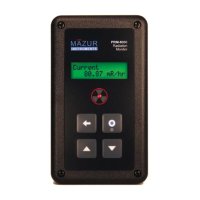PRM-7000 / 8000 / 9000 Users Guide | 27
14. Fundamental Measurement Procedures
14.1 Determining Background Radiation
14.1.1 About Background Radiation
Background Radiation is radioactivity from the environment where the instrument is
present. There are three sources contributing to background radiation; terrestrial, man-
made and cosmic. Although background radiation is present everywhere, the concentra-
tions and distributions are not constant. Certain materials have higher concentrations of
background radiation, and varying environmental and physical conditions can result in
accumulations of background radiation.
Terrestrial Radioactivity
The naturally occurring forms of radioactive elements incorporated into the Earth during
its formation that is still present are referred to as “terrestrial radionuclides.” The most
signifi cant terrestrial radionuclides include the uranium and thorium decay series, potas-
sium-40 and rubidium-87. Virtually all materials found in nature contain some concentra-
tion of terrestrial radionuclides.
Man-Made Radioactive Materials
Nuclear weapons testing and nuclear power reactors have produced large quantities
of radionuclides through the fi ssioning of uranium and other heavy elements and the
activation of various elements. Examples of man-made radionuclides that could be in
the environment are Cesium 137 (137Cs), Strontium 90 (90Sr), and various isotopes of
Plutonium.
Prior to the 1963 Limited Test Ban Treaty, fallout from atmospheric nuclear tests distrib-
uted large quantities of man-made radionuclides around the globe. Following the 1963
treaty, most nuclear weapons tests were conducted underground, although China and
France continued atmospheric testing of nuclear weapons into the late 1970s. In 1996, a
Comprehensive Test Ban Treaty was negotiated with the help of the United Nations. As
of this writing the Comprehensive Test Ban Treaty has not been ratifi ed by China or the
United States and was broken by Pakistan and India in 1998. However, worldwide fallout
concentrations have been declining since the mid 1960s.
In 1964 a Department of Defense weather satellite containing a radiation source failed
to achieve orbit. The Space Nuclear Auxiliary Power (SNAP) 9-A Radioisotopic Ther-
moelectric Generator (RTG) burned up on re-entry and dispersed the nuclear inventory
(primarily plutonium-238) into the atmosphere. Incidents involving Soviet satellites with
radioisotopes or nuclear reactors occurred in 1969, 1973, 1978, and 1983. In April of
1986, there was a non-nuclear steam explosion and fi re at the number four reactor at the
nuclear power plant in Chernobyl in north-central Ukraine. Large quantities of radioactive
material were released into the environment as a result of the catastrophe. The radionu-

